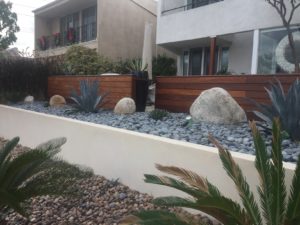When it comes to crafting the perfect outdoor space, homeowners often find themselves faced with a plethora of options. One design element that has gained popularity in recent years is landscape gravel. This versatile material can transform your backyard into a picturesque oasis, but like any landscaping choice, it comes with its own set of pros and cons.
In this article, we’ll explore the advantages and disadvantages of incorporating landscape gravel into your backyard design.

Pros
1. Low Maintenance
Landscape gravel is exceptionally low-maintenance, requiring only occasional raking to keep it looking pristine. Besides, this makes it an ideal choice for those with busy schedules or a desire to reduce water consumption.
2. Excellent Drainage
Gravel facilitates efficient drainage, preventing puddles and erosion in areas prone to heavy rainfall. Also, it can even help protect your foundation from basement flooding by redirecting water away from it.
3. Weed Control
Unlike traditional gardens and lawns, landscape gravel acts as a natural weed barrier, reducing the need for constant weeding and maintenance.
4. Durability
Landscape gravel stands up to foot traffic, pets, and even vehicles without suffering damage, making it an excellent choice for high-traffic areas.
5. Longevity
Gravel doesn’t decompose quickly like mulch. It lasts for generations, ensuring that your landscaping investment endures.
6. Pest Resistance
Unlike decomposing mulch, landscape gravel doesn’t attract pests or provide them with a food source. This can help protect your home from pests like termites.
7. Aesthetic Versatility
With various colors, sizes, and textures available, landscape gravel offers limitless design possibilities, allowing you to personalize your outdoor space to match your style.
8. Ideal for Xeriscaping
In drought-prone regions, landscape gravel complements drought-resistant plants, promoting water-efficient xeriscaping.
Cons
1. Accessibility and Mobility
Landscape gravel can be challenging to walk on for some, limiting its use in activities like barefoot strolls or sports.
2. Potential for Injuries
Care must be taken when mowing or trimming near gravel, as flying rocks can pose injury risks to people, pets, or property. To add, edging or barriers can help mitigate this risk.
3. Sinkage Issues
Over time, gravel can sink into the soil due to foot traffic or heavy rain, requiring periodic maintenance to maintain an even surface.
4. Heat Absorption
Gravel absorbs heat and can raise temperatures in your outdoor space, particularly in hot climates. Hence, additional cooling measures may be necessary to ensure comfort during the hottest months.
5. Noise and Dust
Walking on gravel can be noisy, and in dry climates or high-traffic areas, it can generate dust, requiring regular cleaning.

Incorporating landscape gravel into your backyard design offers numerous advantages, including its durability, low maintenance requirements, and resistance to pests and decomposition. Also, this versatile material can enhance your landscaping, prevent erosion, and support xeriscaping efforts. However, it’s crucial to be mindful of the potential downsides, such as accessibility, maintenance, and heat absorption, and take appropriate measures to address these concerns. To add, the decision to use landscape gravel should align with your specific climate, landscaping goals, and safety considerations, ensuring that it enhances both the aesthetics and functionality of your outdoor oasis.
Explore Choosing the Right Outdoor Lighting Fixtures for Your Home for more ideas.


